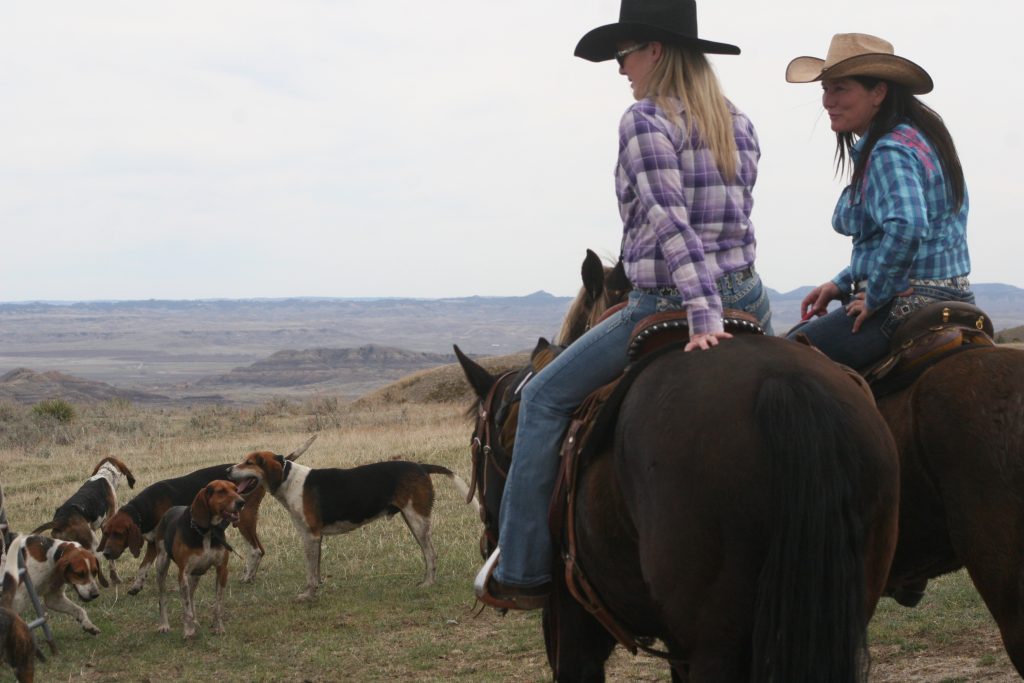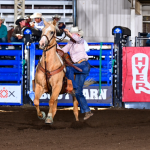2024 Open Season | East Meets West with Big Sky Hounds
Hunting in the West usually involves a rifle, camouflage, and an All-Terrain Vehicle—not red coats, horses and a pack of hounds. That scenario conjures up the green hills of England or the fields and forests of the eastern United States. However, that changed in Montana 20-plus years ago when owners of the Red Rock Hounds based in Reno, Nevada, contacted Renee Daniels and her husband at that time, Kail Mantle, about leasing horses for bringing a traditional “foxhunt” to Montana. The couple owned Montana Horses, which still supplies quality horses to guest ranches, camps, and outfitters.
That pivotal year, Red Rock Hounds owners and Hunt Masters, Lynn Lloyd and Angela Murray, stayed at the historic Sacajawea Hotel in Three Forks. At the time, the hotel was owned by one of the members of Red Rock.
One evening after a week-long coyote hunt, Daniels remembers sitting at a table talking about hunting with Lloyd and Murray, “consuming my share of Scotch and a bit more to make up for those who don’t like the stuff.”
“They asked if I would like to keep a couple of hounds at our ranch,” related Daniels. “I said it was a great idea. The next day, I had a hangover and two hounds.”
The seed for a Montana foxhunt was planted, a hybrid of traditional English-style hunting and Montana’s cowboy heritage.
Big Sky Hounds was born in 2012. “When we first started hunting coyotes, we had four hounds and 45 people,” said Daniels, who still serves as hunt master. A hunt master is responsible for maintaining the financial integrity of the hunt, supervising the hound breeding program, scheduling the hunt meet locations, and getting permission from landowners to hunt.
At first, Big Sky Hounds opted to refrain from formalized hunting, thinking that might deter ranchers from joining.
“I was wrong about my initial impression between fox hunters and ranchers. The ranchers embraced it. It is not hard to see why ‘fiercely individual and pragmatic’ Montanans took to foxhunting so completely,” said Daniels. “It is inherently Western with pride, accomplishment, excitement, camaraderie, challenge and respect. It’s about revering the beautiful country we live in, our magnificent Western horses ideally suited for this, the other bold souls in our tribe, and pushing ourselves just a little further than we thought we could. It is intoxicating. ”
Although the hunt originated in the Three Forks area, Big Sky Hounds expanded their territory to the more open country surrounding Miles City, Montana.
“That came about when Kail and I delivered hay to a ranch northeast of Miles City. We thought, ‘What amazing hunt country.’ We talked to the rancher who purchased our hay, who told us he owned 62 sections and his extended family owned more,” said Daniels.
The family agreed to let Big Sky Hounds hunt the coyotes—as did other neighbors–and now they had hundreds of thousands of acres to call hunt country. When people learned Big Sky Hounds was hunting there, it became so popular that they moved their dates to hunt that country before the Miles City Bucking Horse Sale. It has become a not-to-miss, multi-activity event, with foxhunters from all over the United States zeroing in on eastern Montana in May.
Big Sky Hounds became registered with the Master of Foxhounds in 2015 and recognized in 2018. The Master of Foxhounds Association (MFHA) Association of North America is the governing body of organized mounted hunting with hounds in the United States and Canada. The club recognizes 135 member hunts. To be recognized, the hunt must have approved kennels, adherence to rules, and sportsmanlike conduct.
The Masters of Big Sky Hounds always ask permission to hunt on land. “Our relationship with landowners is sacred,” said Daniels. “The most wonderful ranching families have invited us to ride on their property. We honor them by dressing well, bringing clean horses and showing respect. We are not a wild bunch of people who go crazy.”
The hunt also hosts landowner appreciation days, during which members help with various ranch chores, such as fixing fences or helping with cow work.
Big Sky Hounds members and guests include men and women, youth and older folks, ranchers, cowboys, writers and bankers.
“Our hunt empowers women. They join us from across the country and from different situations,” said Daniels. “Hunting has given many women confidence, and I am proud we have a wonderful tribe of women we’ve empowered.”
Big Sky Hounds hunt mostly coyotes, who run faster and straighter than the traditional foxes in the east. There is also a difference in the hounds needed for hunting the smaller cattle ranches and farm ground around the Gallatin Valley versus the immense tracts of land and open spaces of eastern Montana. That calls for breeding a faster hound with a great nose that also hunts by sight.
“We breed the Western Coyote Hound,” explained Angela Murray, Master and huntsman for Big Sky Hounds. “We have bloodlines of the American Walker Hounds that are 50 years old. We’ve started crossbreeding them with some sight hounds to get more speed. These hounds can catch coyotes in the big Western country. They run on scent and sight.”
Murray grew up hunting and has been able to hunt throughout the country at many hunts. She was at Red Rock Hounds for 20 years and served as Master and huntsman for the last 10. She and Master Richard Pye from Red Rock joined in 2023 as Masters of Big Sky Hounds with Lori Dooley and founding Master Renee Daniels.
Since then, Big Sky Hounds has built a kennel in central Tennessee to winter the pack and has incorporated a traveling component to the home club, providing sport to Montanans and folks from around the country. They have territory in Georgia, Alabama, Texas and Mississippi. This keeps horses, hounds and humans in top shape and ready to head to Montana in May.
Currently, Big Sky Hounds consists of 13.5 couple – a couple is two hounds – meaning it has 27 hounds. When they travel, the entourage includes hounds in the hound truck, horses, horse trailers, and others who come along for good sport.
“We are like a traveling circus when we hit the road,” Murray notes, but says the road trips are half the fun.
She explains the differences between fox hounds and other types of hunting hounds. “Fox hounds live communally, unlike lion hounds or bird dogs, who live individually. The kennels in Montana have four big runs and several lodges so the hounds can get out of the weather, and there are smaller runs for young or injured hounds, as well. The hounds eat together, sleep together, and live together, which helps them develop the cohesion they need to work as a pack.”
As for horses, the staff (huntsmen; whippers-in, who keep an eye on the hounds while they are on a scent; and field staff, who lead the riders behind them) prefer a blooded-type horse, but Murray quickly adds that almost any other breed with a sound mind will work.
“We are a welcoming hunt. You can ride Western or English, and we have members who will help riders new to hunting,” said Murray. “If you do not have a horse, we have horses for lease. We like to maintain tradition and show good sport.”
Big Sky Hounds will begin hunting in the Gallatin Valley in mid-September and would love to have guests. For more information on Big Sky Hounds, visit bigskyhounds.com.








